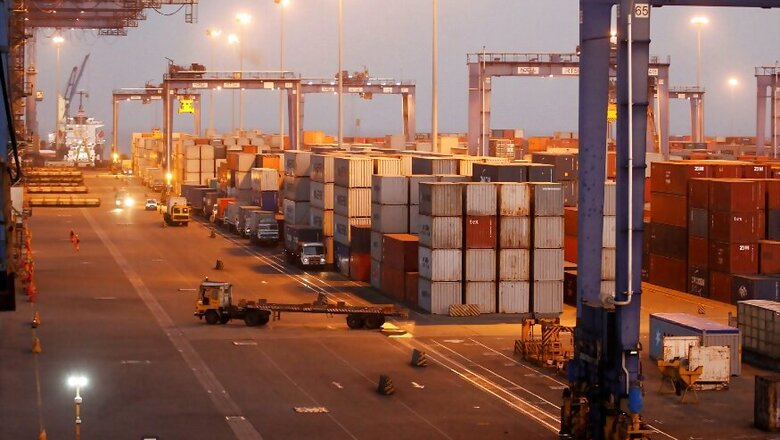
views
The Indian Railways saw gross receipts fall by over Rs 15,000 crore in 2019-20 compared to the previous fiscal and the Covid-19 pandemic only added to its woes further, with an even sharper earnings’ decline in April and May this year. So when freight loading began picking up in June, officials were naturally overjoyed. They said freight loading till June 21 has already reached 90% of the volume seen last June and that loading of steel, cement, foodgrain and fertilizers has actually exceeded the volumes seen in the same month last year.
Freight had dipped by more than a fourth or 28% (by 57.95 million tons) in April and May but 64.52 MT has been loaded in the first three weeks of June and with this, the year-on-year freight volume decline has come down to just 8.31%.
This increased freight loading by the Indian Railways in June is being clubbed with myriad other positive data points by the government to highlight the emergence of green shoots of growth in the economy. Latest numbers from the Centre for Monitoring the Indian Economy (CMIE) are also being cited to show how unemployment has now fallen to pre-Covid levels. The government has been additionally highlighting increased power consumption, increased movement of goods, higher fuel consumption and a good harvest in June.
As India eased the world’s harshest lockdown progressively from the beginning of this month, after two months of a near complete lockdown, economic activity obviously resumed. Should resumption of activity after an unprecedented lockdown be a cause for cheer by itself?
DK Joshi, Chief Economist of ratings agency Crisil, said all indicators of economic activity showed improvement in June because economic activities were curtailed in April and May. “But have things normalised? No, they have not. Are people eating out, taking flights? Our forecast (for GDP growth) remains at minus 5% for FY21 and plus 8.5% for FY22. And these numbers were based on the assumption that the Covid infections would peak in July this year.”
The sale of commercial vehicles and cement are two of the lead markers economists typically use to assess economic recovery. A prominent Mumbai-based vehicle dealer said last week that while sales of two-wheelers were back to about 50% of pre-Covid levels and those of cars had also somewhat rebounded, there had not even been a single inquiry for CVs at his dealership. Vehicle registration data from the Federation of Indian Automobile Dealers (FADA) for May show not a single unit of any CV was registered in May in Delhi when 1,740 units had been registered in May 2019. In Himachal Pradesh, only two CVs were registered against 1,153 in the year ago period. On an overall basis, a mere 2,711 new commercial vehicles were registered in May throughout India against over 80,000 vehicle registrations seen in the same month last year, a decline of over 96%.
If any recovery has happened in June for CVs -- data is yet to come in -- it will most likely be slow and in the smaller CV category. The CV industry anyway continues to expect sales to remain lowest in at least a decade in 2020-21.
As for cement sales, a Mumbai-based brokerage has found through channel checks that demand in the north, south and west regions was merely at 25-50% of pre-Covid levels, but 70-90% in the east and central regions of the country. The spike in east and central is mainly due to rural and private infrastructure demand.
DK Srivastava, Chief Policy Advisor at EY, pointed out that of the eight output sectors which are usually tracked to assess the health of the economy, two remained positive throughout the April-June period -- agriculture and public and defence services.
“These two sectors have a weight of 30%. So 30% of the economy showed growth even in Q1. The remaining 70% output was still negative but the contractionary momentum in these sectors has progressively come down,” he said.
Srivastava said power and petroleum consumption are lead indicators for tracking manufacturing revival and a pickup in manufacturing was seen in June, though it was not on unexpected lines. These indicators had shown a very large contraction in April and early May, but now the “contractionary momentum has slowed down”.
While the government highlights data for three weeks of June to claim that an economic recovery is already underway, economists are still demanding a second round of fiscal stimulus to generate the near-absent demand. In its first attempt, the government has been miserly and mainly addressed supply side issues. Despite claims of a fiscal relief package equaling 10% of the country’s GDP, what has been actually pumped into the system till now is less than 2%.
On the unemployment figures too, what is being highlighted is only a part of the whole picture. The latest CMIE data show that the unemployment rate fell to its pre-lockdown level of 8.5% in the week ended June 21. The rate had spiked from 8.75% in March to 23.5% in April and May, peaking to 27.1% in the week ended May 3. A statement from CMIE showed that the reason for the improvement in employment levels lies in the rural growth story and that unemployment level in urban India was still distinctly higher than the pre-lockdown levels at 11.2% -- still over 200 basis points higher than the 9% average in the period before the lockdown.
Economist Jayati Ghosh said, “This government is always seeing green shoots. The fact that the CMIE employment surveys find more people are back to work only tells us that people who are desperate have no alternative but to seek livelihood in whatever manner they can. Incomes from work would have fallen drastically, many small enterprises are collapsing and formal employment is down.”
All in all, the resumption in economic activities is a welcome development but it is still too early to raise a toast to the Indian economy and its resilience. Because any sustained recovery is closely linked not just to further fiscal stimulus to generate demand, but it is also linked to the way the Covid-19 infection spread and how other global economies fare in the coming months.




















Comments
0 comment